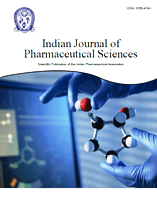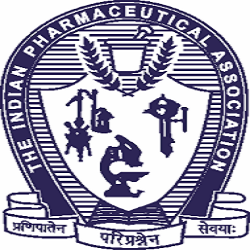- *Corresponding Author:
- J. M. Sasikumar
Department of biotechnology, Karpagam arts and science college, Coimbatore - 641 021, India
E-mail: jmsashikumar@yahoo.co.in
| Date of Submission | 16 May 2006 |
| Date of Revision | 1 March 2007 |
| Date of Acceptance | 5 August 2007 |
| Indian J Pharm Sci, 2007, 69 (4): 581-582 |
Abstract
Antioxidant activity of the crude methanol extract of Pseudarthria viscida (L) Wight and Arn. stem and root was performed by1,1-diphenyl-2-picrylhydrozyl (DPPH) radical quenching assay and reducing power test models. Both stem and root extracts exhibited potential antioxidant activity in both the assays.
https://www.mobafire.com/profile/linayachting12-1120674?profilepage http://www.effecthub.com/user/3726043 http://hawkee.com/profile/4959201/ https://www.youmagine.com/linayachting12/designs https://www.myminifactory.com/users/linayachting12 http://onlineboxing.net/jforum/user/editDone/250273.page [ sonra dön) http://qooh.me/linayachting12 https://linktr.ee/linayachting12 https://pubhtml5.com/homepage/dsgcg/ https://telegra.ph/linayachting12-09-07 https://www.diggerslist.com/64f984f4f355f/about https://allmyfaves.com/linayachting12 https://www.metal-archives.com/users/linayachting12 https://www.catchafire.org/profiles/2491970/ https://www.fimfiction.net/user/634214/linayachting12 https://www.hebergementweb.org/members/linayachting12.550362/ https://www.sqlservercentral.com/forums/user/linayachting12 https://www.twitch.tv/linayachting12/about https://www.roleplaygateway.com/member/linayachting12/ https://www.provenexpert.com/linayachting12/ https://www.intensedebate.com/people/linayachting12 https://www.indiegogo.com/individuals/35167934 https://visual.ly/users/linayachting/portfolio https://slides.com/linayachting12 https://letterboxd.com/linayachting12/ https://micro.blog/linayachting12 https://fliphtml5.com/dashboard/public-profile/rltgx https://community.windy.com/user/linayachting12 https://speakerdeck.com/linayachting12 https://trello.com/u/linayachting/activity https://www.redbubble.com/people/linayachting12/shop?asc=u https://myanimelist.net/profile/linayachting12 https://3dwarehouse.sketchup.com/user/cc47c82a-6986-41b9-bd6c-149a47cfee62/linayachting12-L https://www.wattpad.com/user/linayachting12 https://www.goodreads.com/user/show/169681306-linayachting12 https://en.gravatar.com/linayachting https://tr.pinterest.com/linayachting/ https://www.mapleprimes.com/users/linayachting12 https://medium.com/@linayachting https://www.ted.com/profiles/44969718 https://www.infragistics.com/community/members/441e2ebe309c2bd17fcb6afd43c935449e5dfa08?_ga=2.14597555.501459326.1694087959-1686035490.1694087959 https://www.metooo.io/u/64f9bbcc34cbec3769e6451c https://app.roll20.net/users/12387495/linayachting12-l https://list.ly/linayachting/activity https://giphy.com/channel/linayachting12 https://www.tumblr.com/blog/linayachting12 https://dzone.com/users/4990384/linayachting12.html https://www.creativelive.com/student/linayachting12-linayachting12?via=accounts-freeform_2 https://gab.com/linayachting12 https://sketchfab.com/linayachting12 https://www.flickr.com/people/199088169@N07/ https://devpost.com/linayachting?ref_content=user-portfolio&ref_feature=portfolio&ref_medium=global-nav https://hub.docker.com/u/linayachting12 https://profiles.wordpress.org/linayachting12/ https://wefunder.com/linayachting12 https://seedandspark.com/user/linayachting12-01h9qwzs9mnd1trcccwmcew09j https://calis.delfi.lv/blogs/posts/209629-httpslinayachtingcom/lietotajs/313183-linayachting12/ https://os.mbed.com/users/linayachting12/ https://notionpress.com/author/922335 https://my.desktopnexus.com/linayachting12/ https://guides.co/a/linayachting12-linayachting12/ https://www.bahamaslocal.com/userprofile/1/240146/linayachting12.html http://molbiol.ru/forums/index.php?showuser=1296895 https://www.credly.com/users/linayachting12-linayachting12/badges https://www.facer.io/user/3vGJ7gT2kl https://ko-fi.com/linayachting12#paypalModal https://mastodon.online/@linayachting12 https://www.mobafire.com/profile/marisdentist12-1125518?profilepage https://www.youmagine.com/marisdentist12/designs https://www.myminifactory.com/users/Marisdentist12 http://qooh.me/Marisdentist12 https://linktr.ee/marisdentist12 https://pubhtml5.com/homepage/irvok/ https://telegra.ph/Marisdentist12-10-12 https://www.diggerslist.com/6527ab416b194/about https://allmyfaves.com/Marisdentist12 https://www.catchafire.org/profiles/2528949/ https://www.fimfiction.net/user/647035/Marisdentist12 https://www.hebergementweb.org/members/marisdentist12.567105/ https://www.sqlservercentral.com/forums/user/marisdentist12 https://www.twitch.tv/marisdentist12/about https://www.roleplaygateway.com/member/Marisdentist12/ https://www.provenexpert.com/marisdentist12/?mode=preview https://www.intensedebate.com/people/marisdentist https://www.indiegogo.com/individuals/35553329 https://visual.ly/users/marisdentist/portfolio https://slides.com/marisdentist https://letterboxd.com/marisdentist/ https://fliphtml5.com/dashboard/public-profile/yvpjb https://community.windy.com/user/marisdentist12 https://speakerdeck.com/marisdentist12 https://myanimelist.net/profile/Besthairtranss https://tr.pinterest.com/bodrumboatcharter/ https://3dwarehouse.sketchup.com/user/254a4f67-9bb1-4fc7-9096-dd1522bf7b6c/Marisdentist12-M https://www.wattpad.com/user/Marisdentist12 https://www.goodreads.com/user/show/170807332-marisdentist12 https://gravatar.com/marisdentist https://www.mapleprimes.com/users/Marisdentist12 https://medium.com/@marisdentist https://www.ted.com/profiles/45320558 https://www.infragistics.com/community/members/351b3bc045d83ae22e5708ff24763ea9b1ef0770 https://www.metooo.io/u/652e7f66997f273d46cd4aee https://app.roll20.net/users/12545505/marisdentist12-m https://list.ly/marisdentist/activity https://giphy.com/channel/Marisdentist12 https://www.tumblr.com/blog/marisdentist12 https://www.creativelive.com/student/marisdentist12?via=accounts-freeform_2 https://gab.com/Marisdentist12 https://www.flickr.com/people/199341533@N03/ https://seedandspark.com/user/marisdentist12-01hcyvdwxb0afa947n4ehey3ta https://os.mbed.com/users/marisdentist12/ https://calis.delfi.lv/blogs/lietotajs/319789-marisdentist12/ https://notionpress.com/author/937688 https://my.desktopnexus.com/Marisdentist12/ https://guides.co/a/marisdentist12-marisdentist12/ https://www.bahamaslocal.com/userprofile/1/253850/Marisdentist12.html http://molbiol.ru/forums/index.php?showuser=1304221 https://www.credly.com/users/marisdentist12-marisdentist12/badges https://devpost.com/marisdentist?ref_content=user-portfolio&ref_feature=portfolio&ref_medium=global-nav https://hub.docker.com/u/marisdentist12 http://onlineboxing.net/jforum/user/editDone/255888.page https://micro.blog/Marisdentist12 http://www.effecthub.com/user/3730671 http://hawkee.com/profile/5204276/ https://wefunder.com/marisdentist12 https://www.facer.io/user/9aSpGDtfHR https://mastodon.online/@Marisdentist12 https://sketchfab.com/Marisdentist12 https://profiles.wordpress.org/marisdentist12/ https://dzone.com/users/5006953/marisdentist12.html https://www.metal-archives.com/users/Marisdentist12 https://ko-fi.com/marisdentist12#paypalModal https://www.redbubble.com/people/Marisdentist12/shop?asc=u https://trello.com/u/smilemakeovermarmaris https://www.mobafire.com/profile/hairtransplantistanbul12-1123979?profilepage https://www.myminifactory.com/users/Hairtransplantistanbul12 http://qooh.me/Hairtrans https://linktr.ee/hairtransplantistanbul12 https://pubhtml5.com/homepage/keuqf/ https://telegra.ph/Hairtransplantistanbul12-10-03 https://www.diggerslist.com/651bdf8d1aa91/about https://allmyfaves.com/Hairtransplantistanbul12 https://www.metal-archives.com/users/Hairtransplantistanbul12 https://www.catchafire.org/profiles/2513981/ https://www.fimfiction.net/user/642438/Hairtransplantistanbul12 https://www.hebergementweb.org/members/hairtransplantistanbul12.561212/ https://www.sqlservercentral.com/forums/user/hairtransplantistanbul12 https://www.twitch.tv/hairtransplantistanbul12/about https://www.roleplaygateway.com/member/Hairtransplantistanbul12/ https://www.provenexpert.com/hairtransplantistanbul12/?mode=preview https://www.intensedebate.com/people/hairtransss https://www.indiegogo.com/individuals/35411433 https://visual.ly/users/hairtransplantistanbul1/portfolio https://slides.com/hairtransplantistanbul12 https://letterboxd.com/hairtr/ https://fliphtml5.com/dashboard/public-profile/huyqb https://community.windy.com/user/hairtransss https://trello.com/u/hairtransplantistanbul1 https://myanimelist.net/profile/Besthairtranss https://3dwarehouse.sketchup.com/user/467e62e8-4f1b-44c2-8909-0886e1d75cbd/Hairtransplantistanbul12-H https://www.wattpad.com/user/Hairtransplantt https://www.goodreads.com/user/show/170407199-hairtransplantistanbul12 https://gravatar.com/hairtransplantistanbul1d05b64dcc https://tr.pinterest.com/hairtransplantistanbul0456/ https://www.mapleprimes.com/users/Hairtransplantistanbul12 https://medium.com/@hairtransplantistanbul https://www.ted.com/profiles/45204198 https://www.infragistics.com/community/members/47bcb53f8cd736b453a0f3bd5c5cb221357f8a5b?_ga=2.44052640.565295423.1696333443-628485026.1696333443 https://www.metooo.io/u/651c006666133011a1e6fa3e https://app.roll20.net/users/12492959/hairtransplantistanbul12-h https://list.ly/hairtransplantistanbul/activity https://giphy.com/channel/Hairtransplantistanbul12 https://www.tumblr.com/hairtransplantistanbul12 https://www.creativelive.com/student/hairtransplantistanbul12?via=accounts-freeform_2 https://gab.com/Hairtransplantistanbul12 https://www.flickr.com/people/199330696@N08/ https://seedandspark.com/user/hairtransplantistanbul12-01hbtrdpd3faxe7neg3xcx7eac https://os.mbed.com/users/hairtransplantistanb/ https://calis.delfi.lv/blogs/posts/214807-httpshairtransplantistanbulco/lietotajs/317335-hairtransplantistanbul12/ https://notionpress.com/author/932263 https://my.desktopnexus.com/Hairtransplantistanbul12/ https://guides.co/a/hairtransplantistanbul12-hairtransplantistanbul12/ https://www.bahamaslocal.com/userprofile/1/248731/Hairtransplantistanbul12.html http://molbiol.ru/forums/index.php?showuser=1301605 https://www.credly.com/users/hairtransplantistanbul12-hairtransplantistanbul12/badges https://ko-fi.com/hairtransplantistanbul12#paypalModal https://devpost.com/hairtransplantistanbul?ref_content=user-portfolio&ref_feature=portfolio&ref_medium=global-nav https://www.redbubble.com/people/Hairtranspla/shop?anchor=profile&asc=u http://onlineboxing.net/jforum/user/editDone/253768.page https://micro.blog/Hairtransplant http://www.effecthub.com/user/3729055 https://wefunder.com/hairtransplantistanbul12 https://mastodon.online/@Hairclinicistanbul12 https://sketchfab.com/sam659667 https://profiles.wordpress.org/hairtransplantistanbul12/ https://dzone.com/users/5001589/hairtransplantistanbul12.html https://www.youmagine.com/hairtransplantistanbul12/designs https://speakerdeck.com/hairtransplantistanbul12 https://hub.docker.com/u/hairtransplantistanbul12 https://www.facer.io/user/x3OI1gbrVo http://hawkee.com/profile/5116879/
Keywords
Antioxidant activity, Pseudarthria viscida, DPPH radical, Reducing power
Pseudarthria viscida (L) Wight and Arn. (Fabaceae) is a shrub. The roots are stringent, thermogenic, digestive, anthelmintic, antiinflammatory, diuretic, aphrodisiac, nervine, cardio and rejuvenating tonic. They are useful in vitiated conditions of cough, bronchitis, asthma, tuberculosis, helminthiasis, diarrhoea, inflammation, cardiopathy, fever, hemorrhoids, gout, diabetes, hyperthermia and general debility [1]. The extracts of leaf, root, stem and callus obtained from P. viscida showed significant inhibitory activity against some fungal pathogens causing major diseases in crop plants and stored food grains [2]. The present investigation was undertaken to evaluate the antioxidant activity of stem and root extracts of P. viscida.
The plant material was collected from Kerala and authenticated by the Botanical Survey of India (Southern Circle) Government of India, Coimbatore. The stem and roots were shade dried and powdered. They were exhaustively extracted in Soxhlet apparatus with methanol. Phytochemical analysis of methanol extracts of stem and root was done [3]. Antioxidant activity of the plant extracts was studied by 1,1- diphenyl-2-picrylhydrozyl (DPPH) radical quenching assay and reducing power test models. In vitro DPPH radical scavenging activity was carried out by adopting the method of Blois [4]. Different concentrations of the extracts (1000, 500, 250, 125, 50, 25, 10 µg/ml) were prepared and subjected to antioxidant tests. To 500 µl of each of the extracts, 5 ml of 0.1mM methanol solution of DPPH was added, vortexed, followed by incubation at 27° for 20 min. The control was prepared without any extract and absorbance of the sample was measured at 517nm using UV/ VIS Spectrophotometer (ELICO SL-177, Elico ltd, Hyderabad). Radical scavenging activity was expressed as % inhibition of DPPH radicals. IC50 value was also calculated. The reducing power of the extracts was carried out by using the method of Oyaizu [5]. Different concentrations of the extracts (1000, 500, 250 and125 µg/ml) were prepared. To all the test tubes 2.5 ml of Sodium phosphate buffer followed by 2.5 ml of 1% Potassium ferrocyanide solution was added. The contents were vortexed well and then incubated at 50° for 20 min After incubation, 2.5 ml of 10% trichloroacetic acid was added to all the tubes and centrifugation was carried out at 3000 rpm for 10 min. To 5 ml of the supernatant, 5 ml of distilled water was added. To this about 1 ml of 1% ferric chloride was added to each test tube and incubated at 35° for 10 min. The absorbance was read at 700 nm .The reducing power of the methanol extract was linearly proportional to the concentration of the sample. Ascorbic acid was taken as reference standard. The result of phytochemical analysis was recorded in Table 1. Both the stem and root extracts of P. viscida exhibited potential antioxidant activity in the both the assay models (Tables 2 and 3). The methanol extracts from stem and root of P. viscida showed potent antioxidant activity based on the DPPH and reducing power tests in dose dependent manner. The stem and root extracts strongly scavenged DPPH radicals with the IC50 being 31.01±0.091 and 23.78±0.098 µg/ml, respectively. It also caused significant elevation of reducing power. The higher absorbancy at high concentration indicates the strong reducing power potential. The presence of phenolic compounds might be responsible for the antioxidant activity.
| Chemical components | Stem | Root |
|---|---|---|
| Alkaloids | + | + |
| Steroids and Sterols | - | - |
| Flavonoids | + | + |
| Tannins and Phenolic compounds | + | + |
| Carotenoids | - | - |
| Glycosides | - | - |
| Saponins | + | + |
+indicates presence of compounds; -denotes absence of compounds
Table 1: Phytochemical analysis of P. Viscida
| Concentration (µg/ml) | Stem | IC50 (µg/ml) | Root | IC50 (µg/ml) |
|---|---|---|---|---|
| Inhibition (%) | Mean±Stda | Inhibition (%) | Mean±Stda | |
| Mean±Stda | Mean±Stda | |||
| 1000 | 94.54±0.432 | 86.20±0.094 | ||
| 500 | 94.1±0.163 | 85.13±0.817 | ||
| 250 | 75.03±0.368 | 82.8±0.496 | ||
| 125 | 68.63±1.59 | 69.76±0.786 | ||
| 50 | 56.9±0.409 | 31.01±0.091 | 59.2±0.432 | 23.78±0.098 |
| 25 | 48.36±0.459 | 51.32±0.093 | ||
| 10 | 40.32±0.356 | 41.65±0.612 | ||
| Ascorbic acid (IC50) | 11.24±0.022 |
adenotes Mean ±Std at 95% Confidence Interval
Table 2: Free radical scavenging activity of P. viscida by dpph radical inhibition
| Concentration (µg/ml) |
Absorbance at 700 nm inhibition (Mean±Stda) | |
|---|---|---|
| Stem | Root | |
| 1000 | 0.929±0.0301 | 0.713±0.0387 |
| 500 | 0.571±0.0443 | 0.488±0.0602 |
| 250 | 0.382±0.0946 | 0.382±0.0946 |
| 125 | 0.388±0.0602 | 0.118±0.0602 |
| Control | 0.094±0.001 | Â 0.082±0.4066 |
| Ascorbic acid {1000 (µg/ml)} | 1.634±0.045 | |
adenotes Mean±Std at 95% Confidence Interval
Table 3: Reducing power activity of P. viscida
Acknowledgements
The authors express their sincere gratitude to the management of Karpagam Arts and Science College, Coimbatore.
References
- Warrier PS. Indian Medicinal Plants, 1 st ed. Orient Longman Private Limited: New Delhi; 1994.
- Deepa MA, NarmathaBai V, Basker S. Antifungal properties of Pseudarthriaviscida .Fitoterapia 2004;75:581-4.
- Trease GE, Evans MC. Textbook of pharmacognosy. 12 th ed. Balliere-Tindal: London; 1979. p. 343.
- Blois MS. Antioxidant determinations by the use of stable free radical. Nature 1958;81:1199-2000.
- Oyaizu M. Studies on products of browning reaction: Antioxidant activities of products of browning reaction prepared from glucosamine. Jpn J Nut 1986;44:307-15




